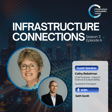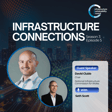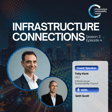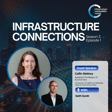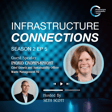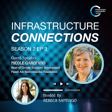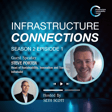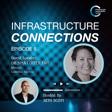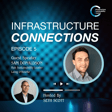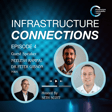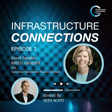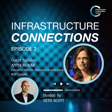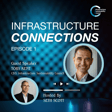Introduction to 'Infrastructure Connections'
00:00:00
Speaker
The planet price just on the environmental side is quite often sort of 20 to 30% the true cost.
00:00:14
Speaker
Welcome back to Infrastructure Connections, the podcast where we explore what makes sustainable infrastructure
Meet Andy Hill, Founder of PlanetPrice
00:00:20
Speaker
work. Brought to you by the Infrastructure Sustainability Council, I'm your host, Seth Scott, and today we're speaking with Andy Hill.
00:00:28
Speaker
Andy is the founder of PlanetPrice, a planetary accounting software that measures the real financial impact of businesses and organizations in the context of planetary boundaries. A mechanical engineer by trade, Andy is also the ANZ director at the M&A firm Hemisphere Partners, and he mentors and serves on the board of several startups.
From Mining to Sustainability: Andy's Journey
00:00:49
Speaker
Hi, Andy. Welcome to the show. Hi, Seth. Thanks for having me. You bet. Thanks for being on. Last season, we interviewed Tanya Hyde at Becca, who was enthusiastic about Planet Price, and they'd used it before. So we're excited to have you on the show. um We'll get to the tool in a minute, but first, let's talk a little bit about how you got here.
00:01:07
Speaker
For 25 years, you ran Oniqua, which was um mining, ah you were managing parts for mining oil and gas and utility companies. um Tell us about that experience, how that led to your thoughts on sustainability, how you moved from mining oil and gas into sustainability and um in those heavy emitting industries and where that got to you today.
00:01:28
Speaker
Yeah, absolutely. So I guess I spent most of my career sort of running around the world, visiting mine sites and oil and gas sites um and you know got got to to see some really pristine parts of the world. so you know very lucky I've sort of traveled through Papua New Guinea and Indonesia and South America and up to Alaska, and um which is fabulous. But along the way, you know obviously, I saw firsthand the environmental impact of those big supply chains and also the social impact, both positive and and sometimes negative as well.
00:02:07
Speaker
So I've always been sort of quietly passionate about sustainability and looking for an opportunity to to make a contribution. You know, what I could see is that those big supply chains, they're very energy intensive, they're very material intensive, there's a lot of waste. And I always thought there must be a way of providing the commodities and the products and the infrastructure that we need, but doing it with ah a smaller footprint on the planet. So I've always had that question sort of burning away.
00:02:38
Speaker
Well, we're glad you did because it led us to where you are today.
Why Financial Quantification of Environmental Impacts Matters
00:02:42
Speaker
We wanted to bring you on because we've seen this increasing trend of adding dollar values to environmental priorities. and um We didn't really see it so much a little over a year ago, but now it's really becoming popular, which is important, ah especially in our current political crisis that we're having. And environmentalists and sustainability professionals, their language isn't necessarily translating to what executives care about.
00:03:07
Speaker
So before we get into that and and Planet Price, let's start at the beginning. um What are the planetary boundaries you're monitoring and why?
PlanetPrice and the Planetary Boundaries
00:03:16
Speaker
Yeah, so so we align PlanetPrice with the planetary boundaries model from the Stockholm Resilience Centre, which is, I think, a fantastic model. um ah There are nine planetary boundaries, and when I first heard about this model, I think we breached four of them.
00:03:35
Speaker
But as you may know, only a few weeks ago, they added ocean acidification. So we've effectively got seven... ah seven hazard lights flashing on the planetary dashboard, if you like. So just just literally and in a matter of years.
00:03:53
Speaker
So those planetary boundaries, obviously the one that most people understand and are focused on is is climate change and greenhouse gases. But we also need to to look at water, land, biodiversity, and various forms of pollution. So there are nine of them in total, and Planet Price models all those.
00:04:13
Speaker
And how does PlanetPrice take those into account?
Harnessing AI for Environmental Impact Assessment
00:04:17
Speaker
Yeah, so so we we we um have an AI model that will take a variety of different types of data and then from that automatically calculate the environment for various environmental impacts. So tons of CO2, meters squared of land occupation, meters cubed of water taken out of the biosphere.
00:04:40
Speaker
ah kilograms of PM2.5 particulate matter put into the air, those sort of things. So we we calculate all of those using the AI model, but then we go this extra step where we apply a societal cost to each one.
00:04:57
Speaker
So we we might say, you know, what is the cost if we put an extra ton of CO2 into the atmosphere? What is the cost to society if we take a metre cubed of fresh water for industrial purposes?
00:05:09
Speaker
What is the cost to society of a single incidence of respiratory disease disease because of air pollution? So we we take numbers from the scientific literature and apply those shadow prices.
00:05:22
Speaker
And then what we get in the end is a planet price. So it's effectively quantifying the environmental impact, but expressing it in financial terms. Sounds like some kind of environmental actuarial science.
00:05:36
Speaker
It is. It is. I mean, that you know as you know, really what we're doing is ah pricing environmental externalities. And it's always sort of fascinated me that there is this huge gap basically in economics.
00:05:50
Speaker
ah you know What we see is that the the planet price just on the environmental side is quite often sort of 20 to 30% of the true cost.
00:06:03
Speaker
So that's a pretty big hole in economics, which which I think we we at least ought to be talking about. It's interesting they they call these externalities, but really it's something that ends up costing us and and usually through our rates and taxes because the government's usually the one picking up the bill at the end of the day.
00:06:21
Speaker
Yeah, that's exactly right. They are real costs. They're they're just not born by by business. They're they're buying by government or society. and you know Obviously, we're seeing that and you know with the increase and in disaster disasters and the investment required in infrastructure for resilience, you know having to design things in a different way, and that's coming at a cost. so I think over time, we will see these costs.
00:06:49
Speaker
you know that They might be external at the moment, but they will gradually become internalized on organizations' profit and loss and balance sheet to some extent. Walk us through how that might
Lifecycle Analysis in Project Assessment
00:07:01
Speaker
work on a project. Take us through ah a general project and what you look at and how you approach it and what the project gets out of it.
00:07:08
Speaker
Yeah, absolutely. so So first thing is we we take a sort of lifecycle approach. ah So you know if we're looking at a piece of infrastructure, we're taking information out of an engineering system, a sort of build quantities, build materials. We're running it through the model and we're sort of calculating the materials and manufacturing piece.
00:07:28
Speaker
And then obviously transport, installation, commissioning and so on. So the first part of the project. But then we're also doing a similar sort of planet price calculation throughout the lifetime of that project.
00:07:41
Speaker
So what is the maintenance? What is the consumables? What is the... you know emissions, the pollution, the operation from that ah asset, for example. And then finally, what happens at end of life?
00:07:54
Speaker
So what is the ultimate destination of the materials? How much of that can be reused or recycled or recovered or or repurposed? So It's a full kind of lifecycle analysis.
00:08:07
Speaker
And at every stage, plan of price is sort of keeping track. So ideally, what you've got then is you've got an economic business case that says, you know, this project is going to cost this much.
00:08:19
Speaker
And over its lifetime, this is the, you know, we've got the capex and the opex. So we've got an economic analysis. But what we're trying to do is give the planet a seat at the table and have a sort of planetary business case across that life cycle as well.
00:08:34
Speaker
um And then obviously what we're hoping is that that will encourage a conversation and about what are different options and could we adjust the economic piece and make a really big difference to the planet price.
00:08:49
Speaker
business case if you like. What kind of organizations are picking up on this and how are they using it?
Sector Applications of PlanetPrice
00:08:55
Speaker
Yeah, so it it tends to be material energy intensive organizations. So infrastructure, transport, construction, mining, utilities, a few sort of governments, you know, as well who also do quite a lot of construction. So councils, various levels of government.
00:09:16
Speaker
ah but also manufacturing and us and and retail because we can do this ah you know at a project level but also at a product level. So you know if you're an online retailer with tens of thousands of product SKUs, we can calculate the plan of price of every one of those products very quickly as well. So those are the sort of organizations that are are taking an interest.
00:09:41
Speaker
I assume there aren't any regulations around this yet that's requiring organizations to do this. So what's driving them from their end? What's their incentive?
The Role of Climate Reporting in Adoption
00:09:50
Speaker
Yeah, yeah. Great question. So um i think a lot of ah probably the largest driver is climate reporting.
00:09:58
Speaker
So particularly scope three in Australia, we have the ASRS regulations in other parts of the world for existing climate reporting legislation or project reporting legislation ah that that's um is getting board attention.
00:10:17
Speaker
um I think the EU is doing a great job as well. they you know So looking at things like digital product passports, carbon border assessment mechanism, adjustment mechanism, they're sort of setting the standard and hopefully some of that regulation will start to move around the world. So, for example, ah they've taken the carbon playbook.
00:10:41
Speaker
And now we have a nature-based playbook coming with the task force for nature-related financial disclosures. So hasn't rolled out yet, but I think some of those compliance reporting things are coming through.
00:10:56
Speaker
I think that's probably the strongest lever. um We are also finding that the more thoughtful companies are seeing something like a planet price as being a metric that can be an input into their strategy and their risk profiles as well. so If you think of planet price as a a lead indicator of what may be coming in your supply chain or in your balance sheet or your investment portfolio, it makes sense to pay attention to it and and start to use it for your planning.
00:11:31
Speaker
Yeah, that was my next question. Are organizations seeing any kind of efficiencies or cost savings coming out of this? um I think it's early days. I think a lot of organizations are still in the mode of, you know, um save money or reduce our impact on the planet, you know, pick one.
00:11:51
Speaker
Yeah. I don't think that's the case. i i you know We have a theory that if you look at any business process through a new lens, whether it's safety or quality or just in time, what you tend to see is waste.
00:12:09
Speaker
And when you eliminate that waste, you you actually save money. So I believe that sustainability and and perhaps you know even further ahead, circularity is just another lens.
00:12:20
Speaker
So I do believe that as people get into it, we will see that you know reducing energy, reducing material usage, recovering materials at end of life is actually a way of just identifying waste and when we eliminate it, we'll save money as well.
00:12:39
Speaker
So one of the things where we're doing a lot of thinking about is how can we use AI to understand the intersection between what saves you money and also reduces planet price.
Procurement: A Critical Area for Impact Quantification
00:12:50
Speaker
And then that's a double no-brainer.
00:12:52
Speaker
You said that 80% of environmental impact comes from procurement. Why is that? And how does this tool help with procurement? Why is procurement the critical point in the process? Yeah, yeah. So I guess businesses, by and large, they they pay people.
00:13:09
Speaker
ah You know, they'd pay they pay their staff and employees and they buy things. So those are sort of the major sort of costs in industrial value chains and and procurement, you know, from the sort of heavier industry can quite often be 80% of those costs. so So for us, that was a world before, and we felt as though that was a really strong lever to to to to to pull if we're if we're going to make a contribution.
00:13:41
Speaker
and I guess over my career, I've seen procurement evolve in terms of its professionalism from really being purchasing as a clerical function to procurement being more a strategic function that that delivered value to the organization. It was more sophisticated.
00:14:01
Speaker
I think we're going to see that evolve again towards more sustainable procurement and circular procurement. i um And, you know, what we're hoping is that planet price can be I suppose, one of the contributors and one of the metrics that can help people to understand that. So essentially what Planet Price does is it quantifies the environmental impact of everything that an organization purchases or sells.
00:14:29
Speaker
So now procurement people have this single metric that they can understand because it's expressed financially that allows them to consider trade-offs.
00:14:40
Speaker
And this was one of the key outcomes from my original research when we interviewed procurement people, they sort of said it's not a fair fight. you know We understand cost.
00:14:51
Speaker
We sort of understand carbon, but when you talk to us about water and pollution, these other things, we we just can't make sense of it. So cost will always win. so that So that was sort of the light bulb moment to say, well, actually, what you're thinking of is cost is not true cost.
00:15:08
Speaker
let's Let's show you what true cost looks like and then It may not still be completely a fair fight, but it's ah a little bit more even. any Any step that gets us closer to perfect knowledge in the market is important. 100%, yeah. yeah um You'd mentioned earlier that a lot of companies are using this for their Scope 3 emissions reporting.
00:15:28
Speaker
And you've just introduced CIRA, your AI platform. Is that is that correct, CIRA? Yes, CIRA, yeah. yeah And um that helps companies. How does that work for their scope three emissions? What does it do to simplify the process? Yeah. So as you know, scope three is is a huge data task.
00:15:45
Speaker
ah it's It's managing lots and lots of data and trying to turn into emissions factors and then turning that into audit ready CO2 numbers.
00:15:58
Speaker
um So what CIRA does is it allows you to use a variety of types of data. ah So for example, it could be procurement transactions. So we could take hundreds of thousands of purchase order lines or invoice descriptions.
00:16:13
Speaker
And instead of a human having to sort of read a massive Excel file and, you know laboriously try and classify it, literally in, you know, in in minutes, it it can process all of that, classify assign the emissions factor, and then give you a complete sort of audit-ready view of the entire organization.
00:16:38
Speaker
so And then... you know from that we can develop heat maps so we understand materiality and hot spots and we start to drill into it. So procurement spend is the starting point but what you then want to do is move to more and more detailed and higher confidence levels of data.
00:16:58
Speaker
So instead of sort of saying I spend a hundred dollars or a thousand dollars on diesel fuel you want to say I bought so many liters of diesel. ah Instead of saying, you know, i spent a million dollars on concrete, you want to move down to, you know, how many meters cubed of 40 megapascals concrete from this supplier.
00:17:20
Speaker
So what we're able to do is use CIRA look at unstructured data like descriptions, to ingest photographs or technical specifications or PDFs, and then from that map it to the highest trust, highest confidence level data we we can possibly find.
00:17:40
Speaker
So it could be an environmental product disclosure disclosure statement, it could be an LCA record, it could be an industry spend record, but it will kind of seamlessly work with whatever data is available.
00:17:55
Speaker
Wow, that's useful. ah Of course, I have to ask this question anytime we bring up AI. this the kind of AI that is power and water hungry on in some server farm somewhere, or is this the kind of AI that runs on a desktop?
00:18:08
Speaker
Yeah, sadly, it is the former. ah they you know the the The size of the models that we're using and and that have come out this year can't really be hosted currently. we We're obviously aware of the water and energy piece. One of the things we do as a B Corp business is we calculate our own planet price and we try and reduce that as an organization. So certainly the compute is costing us money and it's also costing us planet price.
00:18:38
Speaker
So we're very aware of that. But I suppose what we're hoping is that the planet price that we're saving, you know, dwarfs fee of the impact. Well, if you watch the movies, anytime Superman's saving the world, he's knocking a few things over in the process.
00:18:53
Speaker
There you go. I guess as long as we're using it for good rather than evil, then we're on the right track. I think that's a key. I think you know my my son works in AI and you know we often talk about it. And I think one of the key things is AI for good.
00:19:08
Speaker
It's better than making AI cat videos. Yeah, exactly. Yeah. AI for good, not AI for stupidity or AI for evil. You said that water lends itself very well to an internal shadow price.
00:19:22
Speaker
Tell us about these shadow prices. Which ones do you think are going to see more focus in the near future? One that we are researching and um really trying to pay attention to and and keeps coming up in conversations is um what they call novel entities. So this is the planetary boundaries, which is really sort of ah substances that shouldn't be in the biosphere.
00:19:49
Speaker
So particularly microplastics, but also things like PFAS, And I have a feeling that's underreported. I think the science maybe be isn't telling us the the true impact of that.
00:20:03
Speaker
So I wouldn't be surprised if, you know, the planet price numbers we see in a couple of years are showing much higher weighting for things like microplastics.
Empowering Policymakers and Consumers
00:20:14
Speaker
I can see how companies would be interested in it from a specifier and procurement point of view. um How could this be more useful to say policymakers or executives or even the general public?
00:20:26
Speaker
Yeah, that's a great but question. um I think with policymakers, ah it gives them particularly a forward view of risk, which we talked about.
00:20:39
Speaker
you know which we talked about so understanding um you know the planet price component of value chains, whether it's supply chains or asset management or or investment portfolios, I think is very useful.
00:20:56
Speaker
And then i think ah that allows them also to maybe prioritize investments. So you know a transition is going to take time. How do you choose which areas to focus on and which investments to make?
00:21:11
Speaker
So we believe that PlanetPrice, by giving you that sort of, you know, giving that so they the planetary advantage, if you like, in a single number, it allows organizations to perhaps prioritize the investments that they make as they transition to to a more sustainable model.
00:21:32
Speaker
One of the things that we are exploring at the moment is actually almost a consumer version of planet price as well. So we're we're doing some focus groups and market research around, you know, if i was in a if I was in a store and I wanted to buy something, wouldn't it be great if I could just take a photograph of it and understand the planet price?
00:21:55
Speaker
And maybe that might inform my decision making or educate me. That's definitely something we would need in the wider public. um had How do you encourage people inside the infrastructure industry to do what's necessary to prevent planetary overshoot?
00:22:10
Speaker
One of the learnings we've had from from you know doing a number of projects is ah you need to sort of think about it very early on in the project lifecycle.
00:22:22
Speaker
So if you sort of get to the point where the infrastructure is being designed, the engineering is you know, a long way down the track, you've even started to lock in some of the procurements and the costs, there's not much opportunity to change.
00:22:36
Speaker
So it really needs to be a little bit more you know maybe not quite at the whiteboarding stage, but very early on, we hope that the scenario analysis can be more dynamic and more active and perhaps more questions. The organizations can ask ask themselves more ah more questions and answer them very quickly.
00:22:59
Speaker
And that's really what we're hoping with the Planet Price technology is that we can help people answer those questions in days later days rather than months.
Conclusion and Call to Action
00:23:09
Speaker
And so then they'll ask more.
00:23:10
Speaker
And then some of those questions will lead to novel ideas that will influence the overall design and ultimately lead to more sustainable infrastructure. More questions, more information, more data. That's really all we need.
00:23:25
Speaker
Exactly. Yeah, exactly. Well, this has been really helpful. I really appreciate you being on the show. It's been great having you on. a I hope a lot of people start using PlanetPrice. This is definitely something I can see the benefit of out in the market.
00:23:39
Speaker
Thanks. Thanks so much, Seth. Really enjoyed the conversation. Thank you for listening to Infrastructure Connections. Please take a moment to follow us wherever you get your podcasts, and we want to hear your feedback.
00:23:50
Speaker
Leave a message down below to let us know what you thought of this episode, or drop us a line at Infrastructure Sustainability Council. Stay tuned for the next episode of Infrastructure Connections.

